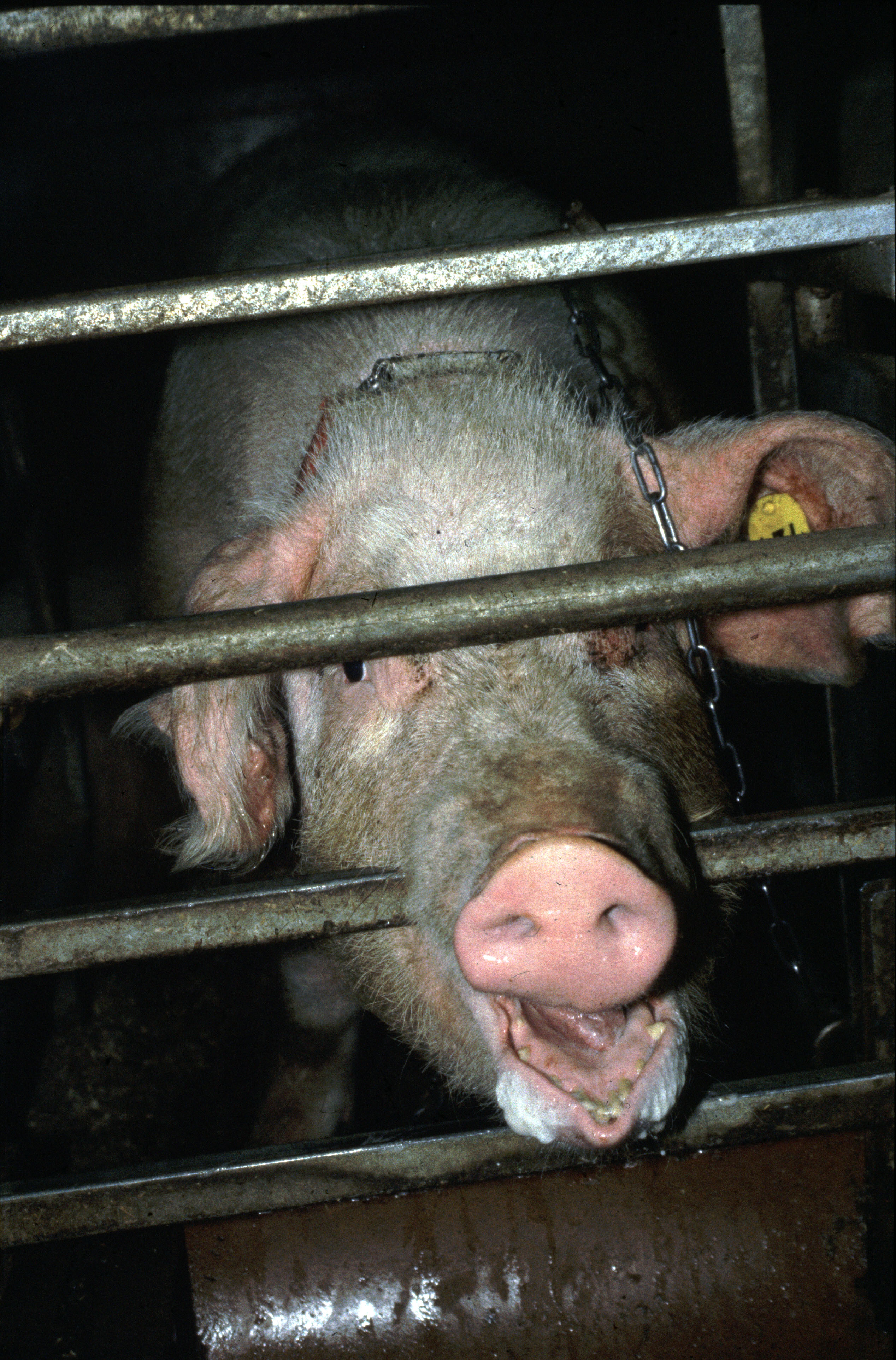Canadians for Ethical Treatment of Food Animals (CETFA) and the Canadian Coalition for Farm Animals (CCFA) have launched a campaign asking Manitoba’s pork industry to voluntarily phase out sow stalls by 2017. The vast majority of breeding pigs kept on Canadian farms are enclosed in sow stalls (or gestation crates) for most of their adult lives. Sow stalls are barren, metal-barred, concrete-floored pens, measuring approximately two by seven feet — the space is so small the animals can’t even turn around.
The campaign seeks to highlight the plight of more than 1.3 million female breeding pigs in Canada, with approximately 318,000 in Manitoba alone. “Scientific evidence increasingly shows sows suffer severely when confined to gestation crates,” reports Twyla Francois, Head of Investigation with CETFA. “In one barn visited by CETFA investigators, sows were so restricted by metal bars that merely shifting position was rendered nearly impossible.”
Research has shown sow stalls severely compromise the animals’ psychological and physical well-being. Confined sows exhibit more aggression and “stereotypies” — repetitive, pointless behaviours such as bar-biting — which are regarded as evidence of mental suffering.
CETFA investigators regularly see sows with injuries, lacerations, muscle weakness, lameness, and bone diseases such as arthritis — all a direct result of sow housing. No animal, human or otherwise, is intended to be stationary and immobilized for days, weeks or months on end. “It’s evolutionary — we need to exercise our muscles or they atrophy, causing all sorts of problems,” states Francois. “The most frequent condition we see in sows who have been forced to exist in such severe confinement is arthritis. These sows exhibit a characteristic loping gait and are clearly experiencing pain with each step. The animals are then at risk of abuse by workers frustrated with their slow progression during transport and slaughter.”
The groups acknowledge the industry’s concern that group housing can also have its welfare challenges. One worry is aggression among sows, especially during feeding. The difference between group housing and stalls, however, is that in group housing, problems can be remedied by good husbandry and management whereas the issues with sow stalls are intrinsic to the system itself. Keeping sows in stable groups and ensuring there is enough space for a submissive sow to escape a dominant ones will help prevent fighting and aggression.
The groups are targeting Manitoba as it is Canada’s largest pig producing province. Additionally, Manitoba Pork’s own recently released report, Embracing a Sustainable Future, makes reference to “animal care” and encourages its producers to stop using sows stalls by 2025.
Despite the Manitoba pork industry’s eventual move away from sow stalls, CCFA and CETFA remain dissatisfied with this announcement. They note that most phase-outs occur on a much shorter timetable. The New Zealand government, for example, outlawed sow stalls last November with the ban to take effect in 2015, and, in the same month, Australian pork producers voluntarily committed to phase out sow stalls as of 2017. Additionally, CCFA and CETFA say Manitoba Pork’s recommendation is weak, allowing producers to choose to continue using stalls or not, even by the 2025 deadline. The groups would like to see a mandated phase-out of stalls.
Unlike most calls for a sow stall phase-out, the groups are also asking industry leaders to recommend their producers house sows in groups on straw. “At the very least, sows should be housed in groups on straw, where the animals can root around and socialize with each other, the way pigs are meant to do,” says Francois. “The urge to build a nest for their oncoming piglets is a powerful one. Sows deserve to have this desire fulfilled. This is good animal welfare — meeting the physical and psychological needs of the animals.”
To spread this message, CETFA and CCFA have launched a new website, www.helpthepigs.com, featuring never-before-seen footage of sows on a Canadian farm crammed into tiny, dismal crates. As well, the groups have jointly produced a 30-second commercial, “Ban Sow Stalls.” The ad began airing on Manitoba on Mother’s Day weekend.
A number of other countries such as the United Kingdom, Sweden and The Netherlands have already banned sow stalls. Seven U.S. states, including Arizona, California, Colorado, Florida, Maine, Michigan and Oregon, are also phasing out or have banned sow stalls. Meanwhile, a legislative ban on sow stalls across the entire European Union is coming in 2013 — less than two years from now.
Canada’s track record for protecting animals through legislation is weak, however, particularly when the animals of concern are those raised and slaughtered for food. At this point, the Manitoba pork industry has already shown it’s moving away from stalls; CCFA and CETFA are hoping to convince them to voluntarily commit to a complete phase-out, sooner rather than later.
Most people are appalled upon learning about how breeding pigs are forced to live in a tiny space for their whole life. CCFA and CETFA are encouraging the public to channel their outrage into action. Ways to help are available on their new website: www.helpthepigs.com.
—–
Lynn Kavanagh writes about animal welfare and protection issues. She is a Director with the Canadian Coalition for Farm Animals (www.humanefood.ca) and helped to develop the website www.pigsatrisk.com, a site dedicated to highlighting issues affecting pigs’ well-being in modern agribusiness.
Photo of bar-biting sow by Willem Schouten.



